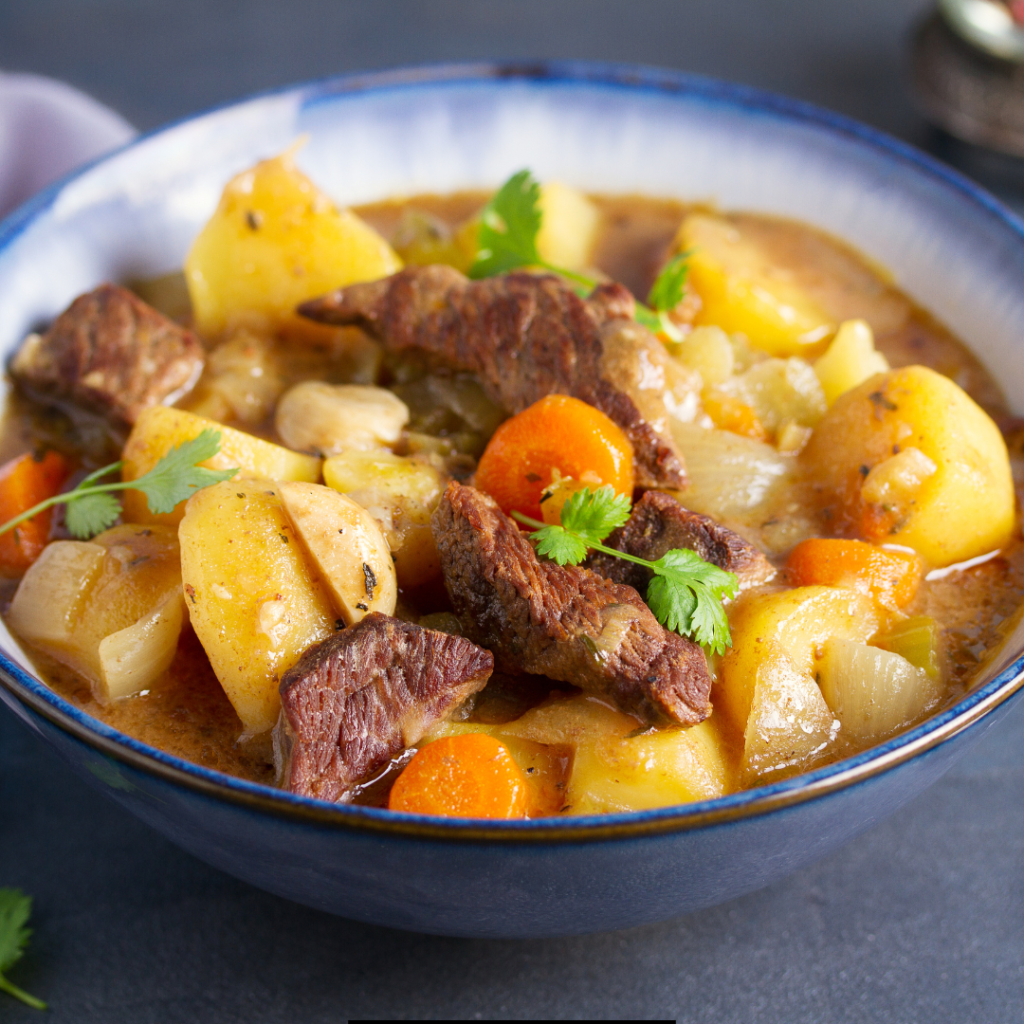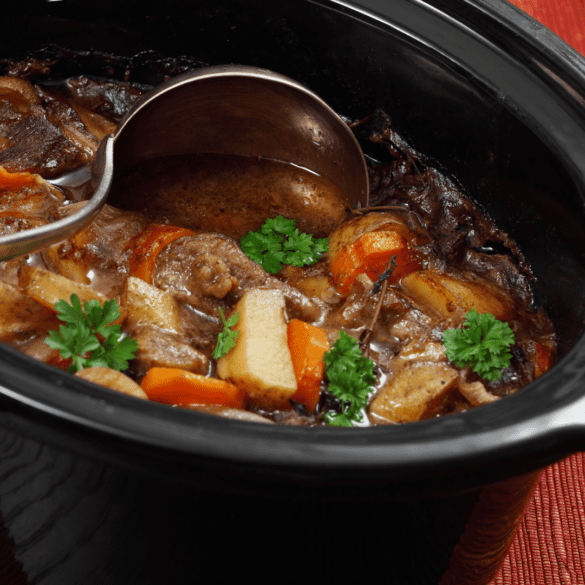What better way to indulge in a cozy night at home than with a hearty bowl of Slow Cooker Beef Stew with Red Wine? My kitchen becomes a sanctuary where the savory scent fills the air, welcoming family and friends to gather around the dinner table.
In my grandmother’s time, beef stew was a testament to resourcefulness, transforming simple ingredients into hearty meals that could last through the cold days. Inspired by her wisdom and armed with my trusty slow cooker, I’ve found that adding a generous pour of red wine to the traditional recipe elevates the humble stew to a new level of sophistication and depth.
How to make Slow Cooker Beef Stew with Red Wine
Slow Cooker Beef Stew with Red Wine is a hearty and flavorful dish that typically consists of beef chunks, vegetables, and a rich sauce made with red wine. The slow cooking process allows the flavors to meld and the beef to become tender.
Ingredients:
- 2 pounds beef chuck, cut into 1-2 inch cubes
- 1/4 cup all-purpose flour
- 2 tablespoons olive oil
- 1 medium onion, chopped
- 2-3 cloves of garlic, minced
- 3 carrots, peeled and sliced into thick rounds
- 2 celery stalks, chopped
- 3 potatoes, peeled and cut into large chunks
- 2 cups beef broth
- 1 cup dry red wine (such as Merlot or Cabernet Sauvignon)
- 1 tablespoon tomato paste
- 1 teaspoon dried thyme
- 1 bay leaf
- Salt and pepper, to taste
- Fresh parsley, chopped (for garnish)
Instructions:
1. Preparing the Beef: First and foremost, season your beef cubes with salt and pepper to taste. Sprinkle the flour over the beef and toss to coat evenly. This helps in thickening the stew and gives the beef a nice crust.
2. Browning the Beef: Heat the olive oil in a skillet over medium-high heat. Add the beef cubes in batches, being careful not to crowd them. Sear them until they’re nicely browned on all sides, then transfer them to your slow cooker. This step adds a deep, rich flavor to your stew.
3. Sautéing the Vegetables: In the same skillet, add a bit more oil if necessary. Sauté the onion, garlic, carrots, and celery until they start to soften and the onions become translucent about 5-6 minutes. Add a splash of red wine to deglaze the pan, scraping up any brown bits from the beef. This process will enrich your stew with complex flavors. Transfer the vegetables into the slow cooker on top of the beef.
4. Slow Cooking: Add the potatoes, beef broth, the remainder of the red wine, tomato paste, dried thyme, and bay leaf to the slow cooker. Stir everything gently to combine. Cover and cook on low for 8-10 hours or on high for 4-5 hours until the beef is fork-tender and the vegetables are soft.
5. Final Touches: Once cooked, remove the bay leaf and adjust the seasoning with salt and pepper as needed. If the stew is too liquid for your liking, mix a tablespoon of cornstarch with two tablespoons of water and stir it into the stew. Cook on high for an additional 15-20 minutes or until thickened.
Tips for the Perfect Stew:
- Choosing the Right Cut: Beef chuck is ideal for stews because it becomes tender and flavorsome after long cooking periods.
- The Wine: Opt for a wine you’d enjoy drinking. The quality of wine influences the depth of flavor in your stew.
- Thickening Your Stew: Always mix cornstarch with cold water before adding it to your stew to avoid lumps.
- Serving: Garnish with fresh parsley before serving for a burst of color and freshness.
- Pairing: Serve with crusty bread or overcooked egg noodles for a more substantial meal.
What to serve with
A well-made Slow Cooker Beef Stew with Red Wine is a symphony of flavors that can stand proudly on its own, but the right accompaniments can enhance this dish, turning a simple meal into an unforgettable feast.
1. Crusty Bread:
Purpose: To sop up the rich, flavorful sauce from the stew.
Types: A loaf of French bread, a ciabatta, or a rustic sourdough offers the perfect texture for dipping.
2. Mashed Potatoes:
Preparation: Creamy, buttery mashed potatoes make an excellent base for beef stew, adding a luxurious texture contrast.
Variations: For a healthier twist, try mashed cauliflower or a mix of potatoes and root vegetables like parsnips.
3. Polenta:
Texture and Flavor: Soft, cooked polenta can be a delightful alternative to more traditional starches, with its smooth texture and subtle corn flavor complementing the robustness of the Slow Cooker Beef Stew with Red Wine.
Serving Tip: Consider adding parmesan cheese to the polenta for an extra flavor boost.
4. Rice:
Simplicity: A simple dish of steamed white rice can serve as a mild base that allows the stew’s flavors to shine.
Variations: Brown rice or wild rice can add a nutty flavor and a bit more texture to your meal.
5. Noodles:
Options: Egg noodles or pappardelle are excellent choices, providing a hearty and satisfying addition to the Slow Cooker Beef Stew with Red Wine.
Preparation: Serve the stew atop a bed of noodles for a comforting and filling meal.
6. Green Salad:
Balance: A crisp green salad dressed with a light vinaigrette can balance the richness of the stew.
Ingredients: Include ingredients like mixed greens, cherry tomatoes, cucumbers, and a sprinkle of nuts for added crunch.
7. Roasted Vegetables:
Variety: Add color and variety to your meal with a side of roasted vegetables like Brussels sprouts, carrots, or asparagus.
Flavor Tip: Roasting brings out the natural sweetness of vegetables, which complements the savory stew beautifully.
8. Yorkshire Pudding:
Traditional: If you’re leaning towards a British-inspired dinner, Yorkshire pudding is a classic choice for pairing with any beef dish.
Serving: Serve them warm and crispy for the best experience.
9. Steamed Green Beans or Broccoli:
Simplicity: Sometimes, a simple side of steamed green beans or broccoli is all you need to add a bit of freshness to your plate without overwhelming the main course.
10. Dessert Pairing:
Suggestion: Following the stew, a simple dessert such as apple pie or a cheese platter can round off the dining experience nicely.
Ingredients Substitutes

Slow Cooker Beef Stew with Red Wine is a classic dish beloved for its deep flavors and comforting qualities. However, sometimes substitutions are necessary due to dietary restrictions, availability of ingredients, or personal preferences.
Red Wine:
Substitutes: If you wish to avoid alcohol, a combination of beef broth and a few tablespoons of balsamic vinegar or red wine vinegar can mimic the acid and depth of flavor. Non-alcoholic red wine is another option, for those who simply don’t have red wine, a good dark beer or stout offers a similar richness.
Beef:
Substitutes: While beef is central to this stew, for a vegetarian alternative, you can use large portobello mushrooms cut into chunks, which provide a meaty texture. Seitan or a hearty vegetable like butternut squash also works well as a replacement in terms of giving substance.
Beef Broth:
Substitutes: Chicken or vegetable broth can be used if you don’t have beef broth. For a richer flavor, try dissolving a bouillon cube in the correct amount of water or using consommé. Mushroom broth can also be a great alternative, especially for vegetarian versions.
Flour (for thickening):
Substitutes: Cornstarch mixed with water (a slurry) can be used as a gluten-free alternative to thicken the stew. Arrowroot powder is another option. Use about half the amount of cornstarch as you would flour.
Carrots, Potatoes, and Other Vegetables:
Substitutes: Feel free to substitute or add additional vegetables based on what you have on hand. Sweet potatoes or parsnips can replace potatoes for a different flavor profile. Turnips and rutabaga are excellent in place of or in addition to carrots.
Onions:
Substitutes: If you don’t have onions, leeks can be a great substitute, offering a milder flavor. Shallots can also work in a pinch, combining garlic and onion flavors.
Garlic:
Substitutes: Garlic powder or granulated garlic can substitute for fresh garlic. As a general guideline, use 1/8 teaspoon of garlic powder for every clove of garlic called for.
Herbs (like thyme and rosemary):
Substitutes: If fresh herbs aren’t available, dried herbs can be used. The general rule of thumb is 1 teaspoon of dried herbs for 1 tablespoon of fresh herbs. If you don’t have the specific herbs on hand, try a premixed Italian seasoning or Herbs de Provence for a similar flavor profile.
Tomato Paste:
Substitutes: For every tablespoon of tomato paste, you can use half a cup of tomato sauce or canned tomatoes reduced down, or even ketchup in a pinch, adjusting the quantity to avoid overpowering the dish.
Final Thoughts
This Slow Cooker Beef Stew with Red Wine is more than just a meal; it’s a warm embrace on chilly evenings, an act of love and care for those gathered around your table.
More Meat Recipes:
- Yard House Maui Pineapple Chicken Recipe
- Magnolia Table King Ranch Chicken Recipe
- Slow Roasted Taco Meat Recipe
- Chicken Claw Sandwich Recipe
- Honey Sesame Chicken Breast Recipe

Ingredients
- 2 pounds beef chuck, cut into 1-2 inch cubes
- 1/4 cup all-purpose flour
- 2 tablespoons olive oil
- 1 medium onion, chopped
- 2-3 cloves of garlic, minced
- 3 carrots, peeled and sliced into thick rounds
- 2 celery stalks, chopped
- 3 potatoes, peeled and cut into large chunks
- 2 cups beef broth
- 1 cup dry red wine (such as Merlot or Cabernet Sauvignon)
- 1 tablespoon tomato paste
- 1 teaspoon dried thyme
- 1 bay leaf
- Salt and pepper, to taste
- Fresh parsley, chopped (for garnish)
Instructions
1. Preparing the Beef: First and foremost, season your beef cubes with salt and pepper to taste. Sprinkle the flour over the beef and toss to coat evenly. This helps in thickening the stew and gives the beef a nice crust.
2. Browning the Beef: Heat the olive oil in a skillet over medium-high heat. Add the beef cubes in batches, being careful not to crowd them. Sear them until they're nicely browned on all sides, then transfer them to your slow cooker. This step adds a deep, rich flavor to your stew.
3. Sautéing the Vegetables: In the same skillet, add a bit more oil if necessary. Sauté the onion, garlic, carrots, and celery until they start to soften and the onions become translucent about 5-6 minutes. Add a splash of red wine to deglaze the pan, scraping up any brown bits from the beef. This process will enrich your stew with complex flavors. Transfer the vegetables into the slow cooker on top of the beef.
4. Slow Cooking: Add the potatoes, beef broth, the remainder of the red wine, tomato paste, dried thyme, and bay leaf to the slow cooker. Stir everything gently to combine. Cover and cook on low for 8-10 hours or on high for 4-5 hours until the beef is fork-tender and the vegetables are soft.
5. Final Touches: Once cooked, remove the bay leaf and adjust the seasoning with salt and pepper as needed. If the stew is too liquid for your liking, mix a tablespoon of cornstarch with two tablespoons of water and stir it into the stew. Cook on high for an additional 15-20 minutes or until thickened.
